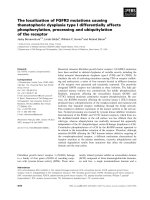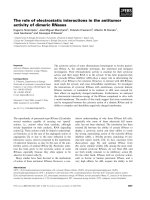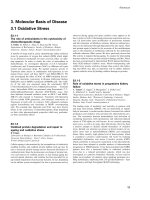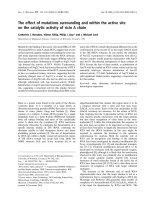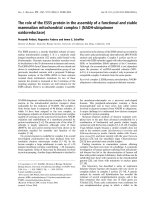Báo cáo khoa học: The importance of being dimeric pptx
Bạn đang xem bản rút gọn của tài liệu. Xem và tải ngay bản đầy đủ của tài liệu tại đây (295.57 KB, 12 trang )
REVIEW ARTICLE
The importance of being dimeric
Giampiero Mei
1,2
, Almerinda Di Venere
1,2
, Nicola Rosato
1,2
and Alessandro Finazzi-Agro
`
1
1 Department of Experimental Medicine and Biochemical Sciences, University of Rome ‘Tor Vergata’, Rome, Italy
2 INFM, University of Rome ‘Tor Vergata’, Rome, Italy
Introduction
The world of globular proteins appears, to a naive
observer, to be very complex. At first sight it is even
difficult to find any regularities that (may) exist.
In particular, the ability of these macromolecules to
reach their final shape among the many different con-
formations in a very short time is astonishing. Small,
globular proteins usually show some interesting corre-
lations between their structural features and the ther-
modynamic parameters characterizing their overall
stability [1]. Other important features (such as surface
hydrophobicity, internal empty and ⁄ or water filled cav-
ities, hydropathic distribution of amino acid residues)
have often been found to play a significant role in the
protein folding process [2,3]; perhaps the most crucial
event for cell life.
The situation is even more complex in the case of
oligomeric structures as no obvious rules concerning
their molecular mass, amino acid composition,
sequence or tridimensional structure are apparent.
An inspection of the list of proteins made by more
than one polypeptide chain shows a striking feature,
namely that of the surprisingly high number of pro-
teins made up of two subunits (Fig. 1). This finding is
even stranger when one realizes that most of these pro-
teins are made up of two identical subunits (Fig. 1).
Let us therefore discuss the meaning of such a pheno-
menon. Obviously, the explanation seems far simpler
when the subunits of a dimer are different. In this case,
each subunit could have a different role; for example,
one subunit may be catalytic and the other regulatory
and this may be the reason for dimer formation. Simi-
larly, it would be understandable if they bound differ-
ent molecules with different affinities.
The situation is more intriguing when one tries to
figure out the meaning of proteins made by identical
subunits. Again, one may think that in the case of
Correspondence
A. Finazzi-Agro
`
, Department of Experimental
Medicine and Biochemical Sciences,
University of Rome ‘Tor Vergata’, Via
Montpellier 1, Rome 00133, Italy
Fax: +39 06 72596468
Tel: +39 06 72596460
E-mail:
Note
This paper is dedicated to the late G. Weber
and W.E. Blumberg who first stimulated our
attention to the problem.
(Received 14 August 2004, revised 17
September 2004, accepted 21 September
2004)
doi:10.1111/j.1432-1033.2004.04407.x
Why are there so many dimeric proteins and enzymes? While for hetero-
dimers a functional explanation seems quite reasonable, the case of homo-
dimers is more puzzling. The number of homodimers found in all living
organisms is rapidly increasing. A thorough inspection of the structural
data from the available literature and stability (measured from denatura-
tion–renaturation experiments) allows one to suggest that homodimers can
be divided into three main types according to their mass and the presence
of a (relatively) stable monomeric intermediate in the folding–unfolding
pathway. Among other explanations, we propose that an essential advant-
age for a protein being dimeric may be the proper and rapid assembly in
the cellular milieu.
Abbreviations
IAR, interface amino acid range; SLL, squared loop length.
16 FEBS Journal 272 (2005) 16–27 ª 2004 FEBS
noncatalytic dimers that bind other molecules, such as
DNA, the protein behaves like a pair of tongs to hold
them in a way appropriate for some other action. A
simple explanation still applies when a catalytic dimer
has the active site at the interface between the sub-
units. However, most catalytic proteins are composed
of identical subunits each containing an ‘active’ site;
thus it remains to be explained why these proteins are
made up of two polypeptide chains instead of being
simply a single chain that is twice as large.
The possible advantages provided by a homodimeric
structure were first advanced by Monod, Wyman and
Changeux in their classic paper about allosteric transi-
tions in enzymes [4]. In this study they emphasized the
fact that isologous associations (i.e. the binding of two
identical subunits, involving identical binding domains)
give rise to ‘closed structures’, with an intrinsic sym-
metry and probably an enhanced stability. They also
suggested that in vivo, a fast formation of the oligo-
meric structure might avoid a random association of
its subunits with other cellular proteins. Experiments
performed by Koshland [5] on the in vitro folding of
mixtures of different oligomers have confirmed this
hypothesis. It was concluded, therefore, that due to
evolutionary selection, the interaction at the intersub-
unit binding site is generally highly specific; its unique-
ness being guaranteed by the rapid formation of each
protomer’s tertiary structure (i.e. during or immedi-
ately after ribosomal translation). Furthermore, in the
early 1980s, high-pressure techniques allowed new and
more detailed studies on the oligomers. In fact, the
mechanical separation of dimeric protein subunits
induces a conformational drift in the protomers’ struc-
ture demonstrating how quaternary interactions can
affect the structure of each monomer [6,7].
In this review we shall present some further possible
reasons for the potential advantage of dimeric proteins
in living systems; in particular genetic saving, func-
tional gain and structural advantage.
Genetic saving
What is the optimum size for an enzyme? Obviously
the length of each polypeptide is a compromise
between two distinct, but equally important, require-
ments: stability and the minimum scaffold necessary to
build up the active site. Evidently, natural evolution
must have accomplished these two goals avoiding any
redundancy, i.e. without wasting materials. Genetic
saving may apply when an oligomeric protein is com-
pared to a monomer of identical size. However, the
energetic balance of synthesizing a polypeptide chain is
only barely accountable for the whole process. Besides
the energy needed for binding the amino acids to their
tRNAs and then to each other when on the polyribo-
somes, one should take into account the energy con-
sumed by the synthesis and preprocessing of mRNA
inside and outside the nucleus, and that needed to
keep the regulation machinery running. A naive
approximation is that to obtain an mRNA twice as
long, one should spend twice the amount of energy.
Therefore the synthesis of a dimer might require signi-
ficantly less energy than that of a monomer of the
same overall molecular mass. This simplistic assump-
tion does not take into account that the probability of
errors during the replication of a gene and its transla-
tion increases in a way more than proportional to the
gene length. Therefore, one should consider the addi-
tional cost for the cell to keep the whole process under
control. Another factor in favor of synthesizing dimers
instead of larger monomers might be the different time
required for ribosomes to walk across shorter mRNAs.
Functional gain
By functional gain we mean any improvement in the
catalytic action of enzymes on substrate(s). This effi-
ciency is governed among others by ‘mechanical’ fac-
tors: (a) the encounter between the two molecules that,
in a diffusion-controlled reaction, depends on bimole-
cular quenching rate [8]; and (b) the orientation factor,
which takes into account the correct lining up between
the substrate to be processed and the active site. The
bimolecular quenching rate is proportional to the
concentration of the enzyme and to the effective
hydrodynamic radius at which the enzyme–substrate
reaction takes place (often approximated to the protein
radius, as the enzyme is generally much larger than the
dimers
hetero
dimers
homo
dimers
trimers
heptamers
tetramers
pentamers
hexamers
octamers
Fig. 1. Percentage distribution of oligomeric proteins (dimers, tri-
mers, tetramers, pentamers, hexamers, heptamers and octam-
ers). Oligomers represent 15% of all the crystallographic data
present to date (August 2004) in literature ( 4200 from a total
of 27 000 structures).
G. Mei et al. The importance of being dimeric
FEBS Journal 272 (2005) 16–27 ª 2004 FEBS 17
substrate). The orientation factor depends instead on
the protein size and, assuming a spherical shape, it can
be approximated by the ratio between the active site
surface and the overall enzyme surface. These three
parameters, namely concentration, radius and enzy-
matic surface, play opposite roles as a function of vol-
ume and no practical advantage can be envisaged for
dimers with respect to monomeric proteins.
A different explanation may call into play the large
structural modifications that occur more easily in
a multidomain enzyme with respect to a rigid, mono-
meric protein. This factor may favor the interaction
between a protein and its ligand according to the
‘induced fit’ model of Koshland [9]. It is well known
that oligomers may display allosteric behavior [4].
However, while this phenomenon is observed fre-
quently in the case of multisubunit proteins, it appears
to be far less common in dimers.
In conclusion, as the above reported factors seem to
be at least of minor importance, one should try to dis-
cover the peculiar features of dimers for a possible cor-
relation between the stability, folding and functional
properties of dimeric proteins.
Structural advantage
Conformational stability and folding
intermediates
A comparison between the stabilization energy per resi-
due for some monomeric and dimeric proteins is shown
in Fig. 2. The data demonstrate clearly a similar trend
for both types, i.e. an exponential decrease, reaching a
constant value above 400 amino acids per subunit. Ten
years ago, Neet and Tim [1] found an approximately
linear correlation between the molecular mass and the
stability of 17 dimeric proteins, although they suggested
that this correlation could not hold for heavier
oligomers. We extended the analysis to some 40 other
dimeric proteins using the data available in the litera-
ture (Table 1), and also taking into account the pres-
ence of intermediate species detected by both kinetic
and equilibrium unfolding measurements. In particular,
we have divided them into three classes according to
the following denaturation patterns: class A, N
2
« 2U;
class B, N
2
« 2I « 2U; class C, N
2
« I
2
« 2U
where N
2
represents the native state, I and I
2
are inter-
mediate monomeric or dimeric species, respectively,
and U is the fully unfolded protein. Although this clas-
sification is somehow weak – in several cases the inter-
mediates may be stabilized or destabilized by the
solvent properties or by introducing ‘ad hoc’ mutations
– it might help to find a possible correlation between
the structural properties and the stability of dimeric
proteins. For example, in the case of globular, mono-
meric proteins, the presence of partially folded states
seems to be correlated strictly to a delicate balance
between the mean charge and hydrophobicity [10]. As
shown in Fig. 3, the pattern appears more complex
than described previously, as no linear relationship
seems to hold between the overall conformational sta-
bility and the size of the proteins. In particular, all
three data sets are characterized by a monotonic
increase in stability, up to a threshold value that varies
from 150 amino acids per subunit (class A) to 350
amino acids per subunit (class C). Then the stabiliza-
tion energy asymptotically drops to lower values ( 12,
15 and 20 kcalÆmol
)1
for the three groups). This behav-
ior is quite reasonable because a stabilization energy
greater than this value could generate ‘indestructible’
proteins unsuited for the continuous making and
breaking that characterizes living systems.
Conformational stability and catalytic activity
The free energy of unfolding is the main parameter
characterizing these three groups of dimers. Further-
more, a functional analysis has shown that only
20% of the proteins of class A reported in Fig. 3A
are enzymes, with 60% and up to 100% in groups
B and C, respectively. This observation suggests
that some correlation may exist among stability, size
and function. As a matter of fact, most of the
smaller proteins belonging to class A are DNA (or
RNA) binding proteins that possibly require a
homodimeric structure only because they have a
‘molecular tweezers-like’ function. The situation is
more complex for the class B and particularly the
class C enzymes.
0.00
0.05
0.10
0.15
0.20
0 200 400 600 800 1000
aa / subunit
∆G
u
/aa (kcal/mol)
Fig. 2. Free energy of unfolding per residue for monomeric (d) and
dimeric (s) proteins as a function of the total number of amino acids.
The importance of being dimeric G. Mei et al.
18 FEBS Journal 272 (2005) 16–27 ª 2004 FEBS
Table 1. List of dimeric proteins divided into three main classes according to their unfolding pathways.
Protein
Residue number
(per subunit)
DG
(kcalÆmol
)1
)
Protein
database code Source Reference
Class A
Dimerization domain of 32 11.5 Rat liver [27]
Transcription factor LFB1
Troponin C LFIL 34 11.0 Skeletal muscle [1]
a
2
(PRR) 35 12.8 Artificial [1]
Arc repressor 53 11.0 1arq Bacteriophage p22 [28]
bZip transcription factor GCN 56 13.5 Rat liver [29]
Dihydrofolate reductase truncated 62 11.3 R plasmid [30]
Repressor of primer Rop 63 17.2 1rop Escherichia coli [1]
Cro repressor 66 11.2 1cro Bacteriophage lambda [31]
Archeal histones 69 14.0 Methanobacterium formicicum [32]
Dihydrofolate reductase 78 13.9 R plasmid [30]
Papilloma virus strain 16E2 80 9.8 1a7g Human [33]
Gene V 87 16.3 1vqb Bacteriophage f1 [34]
HIV-1 protease 99 14.0 1a8g Human [35]
SIV-1 protease 99 13.0 1siv Human [35]
bc-crystallin S3A 103 19.0 1hdf Physarum polycephalum [36]
TRP aporepressor 107 18.8 1wrp E. coli [37]
Mannose-binding lectin 110 13.1 Garlic bulb [38]
Subtilisin inhibitor 113 6.0 3ssi Streptomyces [39]
Nerve grow factor 118 19.3 Mouse [40]
Core histones H2A-H2B 127 11.0 Chicken [41]
b-Lactoglobulin 162 12.0 1beb Bovine [42]
Growth hormone 191 27.8 Human [1]
Glutathione S-transferase P 207 25.3 2gsr Porcine [1]
Glutathione transferase A1-1 221 26.0 1ags Human [43]
Glutathione S-transferase 226 26.0 1gta Schistosoma japonicum [44]
Pea lectin 233 18.8 2ltn Pea seeds [45]
Triosephosphate isomerase 248 19.4 1hti Human [46]
Myo-inositol monophosphate 270 11.5 Pig [47]
Tropomyosin 284 12.4 Chicken [48]
Acid phosphatase 432 6.7 4kbp Red kidney bean [49]
4-amino-N-butyrate transferase 472 12.7 Pig liver [50]
Alkaline phosphatase 580 17.3 Calf [51]
Class B
Four helix boundle protein (a
2
)
2
62 14.3 Artificial [52]
Light chain (LC8) of cytoplasmatic dynein 93 15.9 Drosophila [53]
Lys49-phospholipase 121 17.2 1qll Bothrops jararacussu [54]
Desulfoferrodoxin 125 34.6 1dfx Desulfovibrio desulfuricans [55]
HSOD 153 20.2 1spd Human [56]
PSOD 173 17.3 1yai Photobacterium leiognathi [56]
cAMP receptor protein 209 18.6 1run E. coli [57]
Thymidylate synthase 316 27.5 2tdm Lactobacillus casei [58]
Tyrosyl-tRNA synthetase 319 27.8 1tya Bacillus stearothermophilus [59]
Prostatic acid phosphatase 354 11.0 1cvi Human [60]
Creatine kinase 380 — 2crk Rabbit [61]
Aspartate amino transferase 396 15.9 1aam E. coli [62]
Methionine adenosyl transferase III 396 15.7 Rat [63]
Alkaline phosphatase 580 12.7 Cod [51]
Class C
Histone-like HU protein 90 8.3 1mul E. coli [64]
FIS 98 13.9 1ety E. coli [24]
Hydrolase 336 40.4 1psc Organophosphorus [65]
Luciferase 340 24.2 1luc E. coli [66]
G. Mei et al. The importance of being dimeric
FEBS Journal 272 (2005) 16–27 ª 2004 FEBS 19
An important general feature of enzymes is known
to be their local structural flexibility [11]. It has been
argued that the usually very large ratio between the
dimension of an enzyme and that of its active site is
related to the possibility of finely tuning catalytic activ-
ity. Changes in protein shape are thus fundamental in
exerting biological control in the cell [12] and for
oligomeric proteins, in particular, this has been well
known since the seminal studies on allosterism [4].
However, besides these cooperative mechanisms, it
has been proposed recently that the oligomerization
process itself might tune the enzymatic function. For
example, a structural analysis of several glycolytic
enzymes has suggested that significant changes in their
enzymatic activities do not require large conformation-
al changes [13,14]. It seems that in these cases, the
formation of intersubunit contacts influences the
biological activity by allowing very subtle conforma-
tional changes at the active site in such a way that
oligomerization can indeed activate the monomeric
subunits. These findings are consistent with the small
(but significant) conformational changes observed in
pressure-induced dissociation experiments [6], even
though a generalization of this mechanism to all
dimeric enzymes is not yet warranted [13,14].
Insights on dimer intersubunit surface
The dissociation free energy (DG
diss
) of several dimer-
ic proteins considered in this paper was obtained
from equilibrium unfolding measurements. The DG
diss
values range from 6 to 15 kcalÆmol
)1
, generally
accounting for more than 50% of the total free
energy of unfolding. This finding is consistent with
the widespread idea that the contacts at the surface,
hidden between the monomeric subunits, play a
fundamental role in the stabilization of oligomeric
proteins. Taking advantage of the available crystallo-
graphic data, we have evaluated the ratio between the
dimeric intersubunit interface value and the total
accessible surface area of each monomeric subunit.
This ratio is not constant, the smaller the subunit
size, the larger the contribution of the interface. In
particular, this ratio shows the highest values for very
Table 1. (Continued).
Protein
Residue number
(per subunit)
DG
(kcalÆmol
)1
)
Protein
Database code Source Reference
Prion Ure2 354 49.0 Yeast [67]
Ascorbate oxidase 552 17.0 1aoz Green zucchini [68]
SecA 901 22.5 E. coli [69]
0
10
20
30
0 100 200 300 400 500 600
0 100 200 300 400 500 600
0
10
20
30
40
B
A
C
0
20
40
0 400 800
aa/ subunit
class “A” ∆Gtot (kcal/mol)class “B” ∆Gtot (kcal/mol)class “C” ∆Gtot (kcal/mol)
Fig. 3. Total free energy of stabilization for dimeric proteins that
undergo a simple two-step denaturation process (A) Class A and a
three-step unfolding process with a monomeric (B, class B) or
dimeric (C, class C) intermediate species. Filled symbols represent
those proteins characterized by a linear trend of the DG values vs.
their size.
The importance of being dimeric G. Mei et al.
20 FEBS Journal 272 (2005) 16–27 ª 2004 FEBS
small proteins of class A (Fig. 4A, dashed area). The
crystallographic data indicate that these proteins are
characterized by a very high content of secondary
structure, namely between 60% and 90%. The group
is composed mostly by DNA-binding proteins (such
as ROP, ARC repressor, TRP repressor) and pro-
teases [such as Simian immunodeficiency virus (SIV) and
HIV] or protease inhibitors (e.g. subtilisin inhibitor)
that, despite different tridimensional structures, share
a common functional role for their dimeric interface
(i.e. substrate binding). On the other hand, the all-or-
none transition that characterizes the folding process
of these small dimers strongly suggests that the
assembly of their quaternary structure parallels the
formation of a-helices and ⁄ or b-structures. Thus, a
high number of intersubunit contacts might be
already formed at the earliest steps of the folding
process. Instead, larger dimers display a parallel
increase of both dimeric interface and total accessible
surface area (data not shown), resulting in a constant
percentage of residues present at the interface. The
contribution of the dimeric interface to the total sur-
face buried during folding and dimerization can be
evaluated using the algorithm proposed by Miller
et al. [15] (Fig. 4B). Clearly, the surface hidden at the
dimeric interface represents a significant function of
the buried residues only for small size dimers, while
above a threshold of 100 amino acids per subunit, no
differences are apparent among the three classes of
dimeric proteins.
As the roughness of the monomer contact surface
can be critical for the dimerization process, we have
also checked for the presence of gaps and voids at the
interface of the dimers. The data demonstrated that
the larger the dimer size, the higher the probability of
finding empty (or water-filled) spaces created by the
mismatching of the two monomeric surfaces (data not
shown). Furthermore, for dimers of a given size, those
proteins that have a folding intermediate displayed less
empty volumes, reflecting a different ‘pairing attitude’
of the monomeric subunits that characterize the A, B
and C groups.
Hydrophobic interactions in dimers and the role
of the intersubunit surface
Hydrophobic interactions are essentially due to the bur-
ial of apolar residues in the interior of proteins. As the
volume-to-surface ratio increases with the size of a glob-
ular molecule, one might have expected that the relative
number of hydrophobic residues in a protein also
increased with the length of the polypeptide chain. Early
studies on the ‘hydropathic’ character of proteins [16]
have instead demonstrated that the mean hydropathy
has a fairly constant value that does not depend on the
total number of amino acids. Furthermore, it has been
found recently that a balance exists between the accessi-
bility of hydrophobic and hydrophilic surfaces in most
of 500 proteins [17] independently of the protein
molecular mass. A possible explanation for these find-
ings is the formation of water-filled cavities that arise
from packing defects [2]. In fact, the cavities accommo-
dating water molecules are lined by hydrophilic residues
[3,18]. The dimeric proteins appear to follow the same
rules. The hydrophobicity at the subunit interface
decreases with the polypeptide size (Fig. 5), indicating
that for large dimers the hydrophobic bonds can be pro-
gressively replaced by polar interactions. It appears
therefore that the dimers are held together by nonpolar
interactions in small proteins, but also by salt bridges
and other electrostatic interactions within a suitable
scaffold of hydrophobic residues in the large ones.
Given the rather constant ratio between hydrophobic
0.0
0.1
0.2
0.3
0.4
0 100 200 300 400 500 600
DIS / ASA (per monomer)
A
0
10
20
30
40
0 100 200 300 400 500 600
DIS /(bur surface) (%)
aa/subunit
B
Fig. 4. (A) Fractional contribution of the dimeric intersubunit surface
(DIS) with respect to the total accessible surface area for a mono-
mer (i.e. DIS ⁄ ASA) as a function of the monomer size (class A, h;
B, d and C, m). (B) Fractional contribution to the total buried sur-
face (DIS ⁄ buried surface). The total buried surface upon folding has
been evaluated according to Miller et al. [15]. Dashed areas indicate
the largest change of the fractional dimeric interface (see text).
G. Mei et al. The importance of being dimeric
FEBS Journal 272 (2005) 16–27 ª 2004 FEBS 21
and polar residues, the more polar residues are present
at the interface, the less polar buried in the protein core,
thus, reducing the amount of defects and of protein-
entrapped water. This may represent an important fac-
tor for the stability of larger dimers.
The importance of being dimeric
Taking into account the main structural and functional
features of the three groups of dimers considered so
far, it is tempting to propose a different explanation
for each case, considering the role played by dimeriza-
tion.
Structural functionality: a rationale for smaller
dimers
Small dimers almost all belong to class A and C. Their
function is essentially the binding of other molecules,
often in a very specific and symmetric way. An obvi-
ous example is that of RNAÆDNA binding proteins
(such as ROP). They usually recognize and bind speci-
fic sequences of nucleic acids only in their dimeric
state, immediately loosing this ability if the ‘hinge’, i.e.
the dimer contact, is lost. This is a clear example of a
molecular switch (the on–off positions corresponding
to the dimer–monomer states) that can regulate
important functions in living organisms.
A strict quaternary structure-to-function relationship
is obviously not limited to DNAÆRNA binding pro-
teins. For instance, the active site of small enzymes
(such as, HIV and SIV proteases) requires an appro-
priate large cavity which is provided at the subunit
interface upon oligomerization. In other words, it
appears that the quaternary structure has a ‘structural
functionality’ for most of the small dimeric proteins
and enzymes ( 100 amino acids in length).
Dimerization controls the stability and ‘quality’
of class B proteins
At variance with the above discussed group, the
folding of class B proteins is somehow more closely
related to that of medium-sized monomeric proteins.
In this case each monomer undergoes an independ-
ent assembly process, leading to a rather stable
monomeric intermediate that only dimerizes after
(partial) folding. Indeed it has been found that most
(if not all) of these intermediates resemble the ‘mol-
ten globule’ state found in the folding pathway of
many single chain proteins.
Due to their larger size, the percentage of amino
acid residues present at the subunit interface ( 15%)
is on average much smaller than that observed for
small size dimers ( 42%). Despite this lower contri-
bution to the total buried surface (Fig. 4B), the dimeri-
zation plays a fundamental role in the stabilization of
class B proteins. This is illustrated in Fig. 6, where the
free energy of dissociation (DG
1
) is compared to that
of the monomers unfolding process (DG
2
). It is shown
that DG
1
accounts for more than 60% of the total sta-
bilization energy for half of the proteins considered
and 50% for most of the others. This contribution
might arise from a tighter interaction between the sub-
units in the dimer of class B. Indeed, an analysis of the
crystallographic data shows that in this group of pro-
teins, water is hardly present at the dimeric interface.
More than 50% of the dimers in class A have been
found to contain solvent molecules entrapped within
the two dimers (data not shown).
In conclusion it appears that the role of dimerization
for proteins of class B is mainly structural. However, it
is quite clear that an early dimerization of partially
-0.80
-0.40
0.00
0.40
0 100 200 300 400 500 600
hydropathy (a.u)
aa/subunit
Fig. 5. Hydropathy at the subunit interface for class A dimers (h),
B(d)andC(m).
0.2
0.3
0.4
0.5
0.6
0.7
0.8
0 100 200 300 400 500 600
aa/subunit
∆G (%)
Fig. 6. Relative free energy of stabilization for a two-step unfolding
process of class B dimers. The percentage energy due to dimeriza-
tion (DG
1
⁄DG
TOT
) and to the monomers unfolding energies
(DG
2
⁄DG
TOT
) is reported as filled and unfilled symbols, respectively.
The importance of being dimeric G. Mei et al.
22 FEBS Journal 272 (2005) 16–27 ª 2004 FEBS
folded monomeric intermediates may reduce the risk
of formation of wrong aggregates.
Assembling a dimer that lacks monomeric
intermediates: different folding roles
of quaternary structure?
According to a recent theory, protein folding can be
considered a biased search for the native state on a
rough potential energy surface that represents all the
possible tridimensional conformations [19,20]. Especi-
ally in the case of larger proteins, this search may not
be unidirectional. This means that the unfolded poly-
peptide chains, which populate the disordered unfolded
state, can reach the folded conformation through dif-
ferent pathways, which are characterized by different
local minima. Depending on the energy barriers that
confine these minima, partially folded intermediate
states may be populated, either facilitating the whole
process (‘on-pathway intermediates’) or trapping the
folding molecule in aggregated, misfolded conforma-
tions (‘off-pathway intermediates’). The folding of a
dimeric protein is even more complex, requiring at
some point a bimolecular reaction (the monomers
association) which may take place before, during or
after the formation of secondary and tertiary structure
in each subunit. Theoretical models [21,22] predict that
the folding rate of monomeric proteins decreases not
only with the protein size but also with the number of
long-range contacts, i.e. interactions among residues
that are far away in the primary structure.
It is conceivable that an early interaction between the
nascent monomers may lead to a kinetic bonus in the
folding pathway of dimers, thus, significantly reducing
the degree of freedom of each polypeptide chain. In
other words, the biased search for the final conforma-
tion might be facilitated by a significant reduction of the
potential energy surface roughness upon dimerization.
The characterization of stable dimeric intermediate
states during folding could be very important to test
this hypothesis. Unfortunately, the presence of second-
order kinetics and possible competitive aggregation
processes (that act as kinetic traps) make this experi-
ment particularly difficult. However, a semiquantita-
tive, topological analysis of the dimeric proteins
considered so far might help to find a possible correla-
tion between their size and sequence and quaternary
structure. For this reason we considered the following
two parameters: interface amino acids range (IAR),
which represents the distance (i.e. number of residues)
between the first and last amino acids that take part in
the intersubunit contacts (Fig. 7, upper panel); and
squared loop length (SLL), which is the sum of the
squared distances (in amino acid residues) between two
successive residues of the primary structure involved in
quaternary interactions (Fig. 7, upper panel).
The two parameters have been normalized to the
length of the monomeric subunit (n) and to n
2
,
respectively, so that they both vary between 0 and 1.
The meanings of IAR and SLL are better clarified in
the examples reported in Fig. 7 (1, 2 and 3), represent-
ing three simplified models of the possible quaternary
topologies in homodimers. The values obtained for
class A and class C dimers are reported in Fig. 8 as a
function of subunit length. Both data sets are charac-
terized by a decrease of the IAR parameter with pro-
tein size, while SLL increases initially and, after
reaching a maximum, falls back to lower values. Inter-
estingly, these values for class B dimers do not follow
any regular pattern (data not shown). Comparing this
behavior with the DG data reported in Fig. 3A,C,
indicates that the highest stability of medium-sized
Fig. 7. (Upper panel) Cartoon illustrating the parameters IAR and
SLL. (Lower panel) Representation of three possible quaternary
conformations assumed by dimeric proteins (the dimeric interface
is shown in red). The typical IAR and SLL corresponding values
obtained are reported for each case. The green circles and blue
squares represent the N- and C-terminals respectively.
G. Mei et al. The importance of being dimeric
FEBS Journal 272 (2005) 16–27 ª 2004 FEBS 23
proteins of both classes A and C (i.e. 100 and 350
amino acids per subunit, respectively) is achieved with
large values of IAR and SLL (Fig. 7, model 2). Smal-
ler and larger dimers show large or medium IAR but
small SLL (Fig. 7, models 1 and 3, respectively). These
findings suggest that the quaternary structure gives a
different contribution to the folding process, depending
on the dimer size. Folding is driven by a minimization
energy search that involves both protein and solvent
(water) molecules. Small and medium sized dimers
(£ 100 amino acids per subunit) all show a high con-
tent of secondary structure (‡ 60%) and a high inter-
face hydropathy (Fig. 5). It can be argued, therefore,
that the gain in the stabilization energy upon folding,
DG < 0, may arise from two quite distinct sources: (a)
a large increase of local interactions (DH 0), due to
the formation of a-helices and b-sheets; (b) a relevant
increase of the system entropy (DS 0), arising from
the hydrophobic effect at the subunit interface. The
last effect probably replaces the early, entropy-driven
hydrophobic collapse that leads to the molten globule
states of monomeric proteins [23]. In contrast, the sta-
bilization mechanism of larger dimers appears to be
quite different. They have a significantly smaller per-
centage of secondary structure (on the average less
than 40%), which probably reduces the enthalpy con-
tribution to stability, and a less hydrophobic dimeric
interface (Fig. 5), suggesting also a smaller contribu-
tion of quaternary interactions to DS.
This is only partially counterbalanced by the pres-
ence of hydrogen bonds, salt-bridges and other polar
interactions at the subunit interface, explaining the
decrease in the DG beyond certain molecular mass
values reported in Fig. 3.
In conclusion we believe that the large number of
homodimeric proteins found in living systems does
not occur by chance. For class B dimers, the dimeri-
zation process might find a rationale in the protec-
tion and stabilization of those molten globule states
that alone are not able to complete their self-assem-
bly process. When a quasi-native monomeric inter-
mediate is not formed, a role of dimerization in the
assembly process is less understandable, but we sus-
pect that it is an important way of making the fold-
ing of proteins correct and fast. In other words,
both early interacting unfolded monomers (class A
and C) and partially folded monomers (class B) may
act as chaperones for their partners. However, the
experimental proof for this hypothesis will require
the careful study of denaturation–renaturation of
dimeric proteins under experimental conditions (vis-
cosity, molecular crowding, presence of chaperones)
more similar to the in vivo folding milieu. Very
recently, dimeric folding intermediates have also been
found in the folding pathway of small DNA binding
proteins [24,25] where they are also thought to play
a critical functional role [25]. This finding not only
underlines the great importance of partially folded
oligomeric structures but also demonstrates that their
presence in the protein folding world might be much
more common than found up to now.
Experimental procedures
A list of the dimeric proteins considered in this study is
shown in Table 1 according to the specific unfolded path-
way reported in the literature.
The dimeric interface and the gap volume at the dimer
interface have been evaluated using the ‘Protein–Protein’
Interaction Server ( />server/) [26]. Hydropathy at the dimeric interface was
evaluated according to the amino acid hydropathy scale
reported by Kyte and Doolittle [16]. In particular, the
hydropathy of each amino acid side chain was weighted by
its specific interface accessible surface area (provided by the
‘Protein Protein’ Interaction Server) and their sum arbitrar-
ily normalized within the range ()1 ⁄ +1).
0.20
0.40
0.60
0.80
1.00
0.00
0.05
0.10
0.15
0.20
0.25
0 100 200 300 400 500
SLL SLL
aa/subunit
0.20
0.40
0.60
0.80
1.00
0.00
0.05
0.10
0.15
0.20
0.25
0 100 200 300 400 500 600
aa/subunit
class “C”
class “A”
IAR IAR
Fig. 8. IAR (d) and SLL (s) value of class A (upper panel) and class
C (lower panel) dimers. The dashed, dotted and gray areas corres-
pond to the interface models (1, 2 and 3) shown in Fig. 7.
The importance of being dimeric G. Mei et al.
24 FEBS Journal 272 (2005) 16–27 ª 2004 FEBS
References
1 Neet KE & Timm DE (1994) Conformational stability
of dimeric proteins: quantitative studies by equilibrium
denaturation. Protein Sci 3, 2167–2174.
2 Hubbard JS, Gross KH & Argos P (1994) Intramolecu-
lar cavities in globular proteins. Protein Eng 7, 613–626.
3 Williams MA, Goodfellow JM & Thornton JM (1994)
Buried waters and internal cavities in monomeric pro-
teins. Protein Sci 3, 1224–1235.
4 Monod J, Wyman J & Changeux JP (1965) On the nat-
ure of allosteric transitions: a plausible model. J Mol
Biol 12, 88–118.
5 Cook RA & Koshland DE (1969) Specificity in the
assembly of multisubunit proteins. Proc Natl Acad Sci
USA 64, 247–254.
6 Weber G (1986) Phenomenological description of the
association of protein subunits subjected to conforma-
tional drift. Effects of dilution and of hydrostatic
pressure. Biochemistry 25, 3626–3331.
7 Weber G (1987) Fluorescence spectroscopy at high
pressure: techniques and results. In Current Perspectives
in High Pressure Biology , pp. 235–243. Academic Press
Inc. London.
8 Cantor CR & Schimmel PR (1980) Biophysical Chemis-
try, W.H. Freeman & Co. San Francisco, CA, USA.
9 Yu EW & Koshland DE Jr (2001) Propagating
conformational changes over long (and short) distances
in proteins. Proc Natl Acad Sci USA 98, 9517–9520.
10 Uversky VN (2002) Cracking the folding code. Why do
some proteins adopt partially folded conformations
adopt partially folded conformations, whereas other
don’t? FEBS Lett 514, 181–183.
11 Careri G, Fasella P & Gratton E (1979) Enzyme
dynamics: the statistical physics approach. Annu Rev
Biophys Bioeng 8, 69–97.
12 Koshland DE (1973) Protein shape and biological con-
trol. Sci Am 229, 52–64.
13 Torshin IY (1999) Activating oligomerization as inter-
mediate level of signal transduction: analysis of protein-
protein contacts and active sites in several glycolytic
enzymes. Front Biosci 4, d557–570.
14 Torshin IY (2002) Functional maps of the junctions
between interglobular contacts and active sites in glyco-
lytic enzymes – a comparative analysis of the biochemical
and structural data. Medical Sci Monit 8, BR123–135.
15 Miller S, Lesk AM, Janin J & Chothia C (1987) The
accessible surface area and stability of oligomeric pro-
teins. Nature 328, 834–836.
16 Kyte J & Doolittle RF (1982) A simple method for dis-
playing the hydropathic character of a protein. J Mol
Biol 157, 105–132.
17 Lins L, Thomas A & Brasseur R (2003) Analysis of
accessible surface of residues in proteins. Proteins Sci
12, 1406–1417.
18 Zhang L & Hermans J (1996) Hydrophilicity of cavities
in proteins. Proteins 24, 433–438.
19 Dinner AR, Sali A, Smith LJ, Dobson CM & Karplus M
(2000) Understanding protein folding via free-energy sur-
faces from theory and experiment. Trends Biochem Sci
25, 331–339.
20 Brooks CL III, Onuchic JN & Wales DJ (2001) Taking
a walk on a landscape. Science 293, 612–613.
21 Plaxco KW, Simons KT & Baker D (1998) Contact
order, transition state placement and the refolding rates
of single domain proteins. J Mol Biol 277, 985–994.
22 Ivankov DN, Garbuzynskiy SO, Alm E, Plaxco KW,
Baker D & Finkelstein AV (2003) Contact order revis-
ited: influence of protein size on the folding rate. Protein
Sci 12, 2057–2062.
23 Tsai CJ, Maizel JV Jr & Nussinov R (2002) The hydro-
phobic effect: a new insight from cold denaturation and
a two-state water structure. Crit Rev Biochem Mol Biol
37, 55–69.
24 Topping TB, Hoch DA & Gloss LM (2004) Folding
mechanism of FIS, the intertwined, dimeric factor for
inversion stimulation. J Mol Biol 335, 1065–1081.
25 Ramstein J, Hervouet N, Coste F, Zelwer C, Oberto J
& Castaing B (2003) Evidence of a thermal unfolding
dimeric intermediate for the Escherichia coli histone-like
HU proteins: thermodynamics and structure. J Mol Biol
331, 101–121.
26 Jones S & Thornton JM (1996) Principles of protein–
protein interactions derived from structural studies.
Proc Natl Acad Sci USA 93, 13–20.
27 De Francesco R, Pastore A, Vecchio G & Cortese R
(1991) Circular dichroism study on the conformational
stability of the dimerization domain of transcription fac-
tor LFB1. Biochemistry 30, 143–147.
28 Bowie JU & Sauer RT (1989) Equilibrium dissociation
and unfolding of the Arc repressor dimer. Biochemistry
28, 7139–7143.
29 Thompson KS, Vinson CR & Freire E (1993) Thermo-
dynamic characterization of the structural stability of
the coiled-coil region of the bZIP transcription factor
GCN4. Biochemistry 32, 5491–5496.
30 Reece LJ, Nichols R, Ogden RC & Howell EE (1991)
Construction of a synthetic gene for an R-plasmid-
encoded dihydrofolate reductase and studies on the role
of the N-terminus in the protein. Biochemistry 12,
10895–10904.
31 Jana R, Hazbun TR, Mollah AK & Mossing MC
(1997) A folded monomeric intermediate in the forma-
tion of lambda Cro dimer-DNA complexes. J Mo1 Biol
273, 402–416.
32 Li WT, Grayling RA, Sandman K, Edmondson S,
Shriver JW & Reeve JN (1998) Thermodynamic stability
of archaeal histones. Biochemistry 37, 10563–10572.
33 Mok YK, de Prat Gay G, Butler PJ & Bycroft M
(1996) Equilibrium dissociation and unfolding of the
G. Mei et al. The importance of being dimeric
FEBS Journal 272 (2005) 16–27 ª 2004 FEBS 25
dimeric human papillomavirus strain-16, E2 DNA-bind-
ing domain. Protein Sci 5, 310–319.
34 Liang H & Terwilliger TC (1991) Reversible denatura-
tion of the gene V protein of bacteriophage f1. Biochem-
istry 30, 2772–2782.
35 Grant SK, Deckman IC, Culp JS, Minnich MD, Brooks
IS, Hensley P, Debouck C & Meek TD (1992) Use of
protein unfolding studies to determine the conforma-
tional and dimeric stabilities of HIV-1 and SIV pro-
teases. Biochemistry 31, 9491–9501.
36 Kretschmar M & Jaenicke R. (1999) Stability of a
homo-dimeric Ca(2+)-binding member of the beta
gamma-crystallin superfamily: DSC measurements on
spherulin 3a from Physarum polycephalum. J Mol Biol
291, 1147–1153.
37 Reedstrom RJ, Martin KS, Vangala S, Mahoney S,
Wilker EW & Royer CA (1996) Characterization of
charge change super-repressor mutants of trp repressor:
effects on oligomerization conformation, ligation and
stability. J Mol Biol 264, 32–45.
38 Bachhawat K, Kapoor M, Dam TK & Surolia A (2001)
The reversible two-state unfolding of a monocot man-
nose-binding lectin from garlic bulbs reveals the domi-
nant role of the dimeric interface in its stabilization.
Biochemistry 40, 7291–7300.
39 Tamura A, Kojima S, Miura K & Sturtevant JM (1995)
A thermodynamic study of mutant forms of Strepto-
myces subtilisin inhibitor. II. Replacements at the inter-
face of dimer formation, Val13. J Mol Biol 249, 636–
645.
40 Timm DE, de Haseth PL & Neet KE (1994) Compara-
tive equilibrium denaturation studies of the neurotro-
phins: nerve growth factor, brain-derived neurotrophic
factor, neurotrophin 3, and neurotrophin 4 ⁄ 5. Biochem-
istry 33, 4667–4676.
41 Karantza V, Baxevanis AD, Freire E & Moudrianakis
EN (1995) Thermodynamic studies of the core histones:
ionic strength and pH dependence of H2A-H2B dimer
stability. Biochemistry 34, 5988–5996.
42 D’Alfonso L, Collini M & Baldini G (2002) Does beta-
lactoglobulin denaturation occur via an intermediate
state? Biochemistry 41, 326–333.
43 Wallace LA, Sluis-Cremer N & Dirr HW (1998) Equili-
brium and kinetic unfolding properties of dimeric
human glutathione transferase A1–1. Biochemistry 37 ,
5320–5328.
44 Kaplan W, Husler P, Klump H, Erhardt J, Sluis-Cremer
N & Dirr. H (1997) Conformational stability of pGEX-
expressed Schistosoma japonicum glutathione S-trans-
ferase: a detoxification enzyme and fusion-protein
affinity tag. Protein Sci 6, 399–406.
45 Ahmad N, Srinivas VR, Reddy GB & Surolia A (1998)
Thermodynamic characterization of the conformational
stability of the homodimeric protein, pea lectin. Bio-
chemistry 37, 16765–16772.
46 Mainfroid V, Terpstra P, Beauregard M, Frere JM,
Mande SC, Hol WG, Martial JA & Goraj K (1996)
Three hTIM mutants that provide new insights on why
TIM is a dimer. J Mol Biol 257, 441–456.
47 Kwon OS, Lo SC, Kwok F & Churchich JE (1993)
Reversible unfolding of myo-inositol monophosphatase.
J Biol Chem 268, 7912–7916.
48 Lehrer SS & Stafford WF 3rd (1991) Preferential assem-
bly of the tropomyosin heterodimer: equilibrium studies.
Biochemistry 30, 5682–5688.
49 Cashikar AG & Rao NM (1996) Unfolding pathway in
red kidney bean acid phosphatase is dependent on
ligand binding. J Biol Chem 271, 4741–4746.
50 Pineda T & Churchich JE (1994) Unfolding of 4-amino-
butyrate aminotransferase equilibrium and kinetic stu-
dies. Biochim Biophys Acta 1207, 173–178.
51 Asgeirsson B, Hauksson JB & Gunnarsson GH (2000)
Dissociation and unfolding of cold-active alkaline phos-
phatase from atlantic cod in the presence of guanidi-
nium chloride. Eur J Biochem 267, 6403–6412.
52 Chapeaurouge A, Johansson JS & Ferreira ST (2002)
Folding of a de novo designed native-like four-helix
bundle protein. J Biol Chem 277, 16478–16483.
53 Barbar E, Kleinman B, Imhoff D, Li M, Hays TS &
Hare M (2001) Dimerization and folding of LC8, a
highly conserved light chain of cytoplasmic dynein.
Biochemistry 40, 1596–1605.
54 Ruller R, Ferreira TL, de Oliveira AH & Ward RJ
(2003) Chemical denaturation of a homodimeric lysine-
49 phospholipase A2: a stable dimer interface and a
native monomeric intermediate. Arch Biochem Biophys
411, 112–120.
55 Apiyo D, Jones K, Guidry J & Wittung-Stafshede P
(2001) Equilibrium unfolding of dimeric desulfoferro-
doxin involves a monomeric intermediate: iron cofactors
dissociate after polypeptide unfolding. Biochemistry 40,
4940–4948.
56 Stroppolo ME, Malvezzi-Campeggi F, Mei G, Rosato
N & Desideri A (2000) Role of the tertiary and quatern-
ary structures in the stability of dimeric copper, zinc
superoxide dismutases. Arch Biochem Biophys 377, 215–
218.
57 Malecki J & Wasylewski Z (1997) Stability and kinetics
of unfolding and refolding of cAMP receptor protein
from Escherichia coli. Eur J Biochem 243, 660–669.
58 Gokhale RS, Agarwalla S, Santi DV & Balaram P
(1996) Covalent reinforcement of a fragile region in the
dymeric enzyme thymidylate synthase stabilizes the pro-
tein against chaotrope-induced unfolding. Biochemstry
35, 7150–7158.
59 Park YC & Bedouelle H (1998) Dimeric tyrosyl-tRNA
synthetase from Bacillus stearothermophilus unfolds
through a monomeric intermediate. A quantitative ana-
lysis under equilibrium conditions. J Biol Chem 273,
18052–18059.
The importance of being dimeric G. Mei et al.
26 FEBS Journal 272 (2005) 16–27 ª 2004 FEBS
60 Wojciak P, Mazurkiewicz A, Bakalova A & Kuciel R.
(2003) Equilibrium unfolding of dimeric human pro-
static acid phosphatase involves an inactive monomeric
intermediate. Int J Biol Macromol 32, 43–54.
61 Couthon F, Clottes E, Ebel C & Vial C (1995) Reversi-
ble dissociation and unfolding of dimeric creatine kinase
isoenzyme MM in guanidine hydrochloride and urea.
Eur J Biochem 234 , 160–170.
62 Herold M & Kirschner K (1990) Reversible dissociation
and unfolding of aspartate aminotransferase from
Escherichia coli: characterization of a monomeric inter-
mediate. Biochemistry 29, 1907–1913.
63 Gasset M, Alfonso C, Neira JL, Rivas G & Pajares MA
(2002) Equilibrium unfolding studies of the rat liver
methionine adenosyltransferase III, a dimeric enzyme
with intersubunit active sites. Biochem J 361, 307–315.
64 Ramstein J, Hervouet N, Coste F, Zelwer C, Oberto J
& Castaing B (2003) Evidence of a thermal unfolding
dimeric intermediate for the Escherichia coli histone-like
HU proteins: thermodynamics and structure. J Mol Biol
331, 101–121.
65 Grimsley JK, Scholtz JM, Pace CN & Wild JR (1997)
Organophosphorus hydrolase is a remarkably stable
enzyme that unfolds through a homodimeric intermedi-
ate. Biochemistry 36, 14366–14374.
66 Clark AC, Sinclair JF & Baldwin TO (1993) Folding of
bacterial luciferase involves a non-native heterodimeric
intermediate in equilibrium with the native enzyme
and the unfolded subunits. J Biol Chem 268, 10773–
10779.
67 Zhu L, Zhang XJ, Wang LY, Zhou JM & Perrett S
(2003) Relationship between stability of folding inter-
mediates and amyloid formation for the yeast prion
Ure2p: a quantitative analysis of the effects of pH and
buffer system. J Mol Biol 328, 235–254.
68 Mei G, Di Venere A, Buganza M, Vecchini P, Rosato
N & Finazzi-Agro
`
A (1997) Role of quaternary struc-
ture in the stability of dimeric proteins: the case of
ascorbate oxidase. Biochemistry 36, 10917–10922.
69 Doyle SM, Braswell EH & Teschke CM (2000) SecA
folds via a dimeric intermediate. Biochemistry 39,
11667–11676.
G. Mei et al. The importance of being dimeric
FEBS Journal 272 (2005) 16–27 ª 2004 FEBS 27
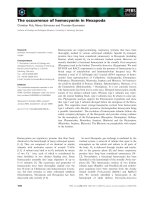
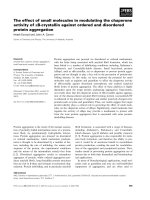
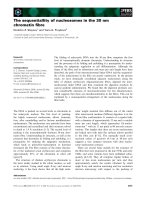
![Tài liệu Báo cáo khoa học: The stereochemistry of benzo[a]pyrene-2¢-deoxyguanosine adducts affects DNA methylation by SssI and HhaI DNA methyltransferases pptx](https://media.store123doc.com/images/document/14/br/gc/medium_Y97X8XlBli.jpg)
